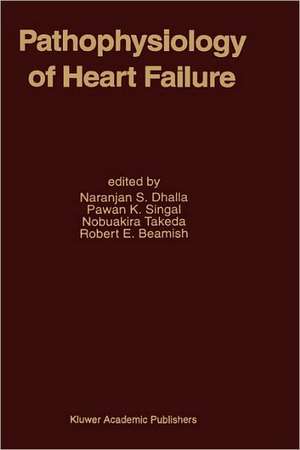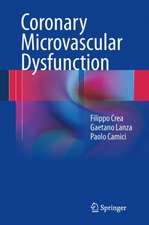Pathophysiology of Heart Failure: Developments in Cardiovascular Medicine, cartea 168
Editat de Naranjan S. Dhalla, Pawan K. Singal, Nobuakira Takeda, Robert E. Beamishen Limba Engleză Hardback – 31 dec 1995
Audience: Clinical and experimental cardiologists will find the book a helpful source of ideas and inspiration.
| Toate formatele și edițiile | Preț | Express |
|---|---|---|
| Paperback (1) | 1112.17 lei 43-57 zile | |
| Springer Us – 17 sep 2011 | 1112.17 lei 43-57 zile | |
| Hardback (1) | 1939.63 lei 43-57 zile | |
| Springer Us – 31 dec 1995 | 1939.63 lei 43-57 zile |
Din seria Developments in Cardiovascular Medicine
- 5%
 Preț: 1484.50 lei
Preț: 1484.50 lei - 5%
 Preț: 375.17 lei
Preț: 375.17 lei - 5%
 Preț: 354.10 lei
Preț: 354.10 lei - 5%
 Preț: 1419.03 lei
Preț: 1419.03 lei - 5%
 Preț: 376.43 lei
Preț: 376.43 lei - 5%
 Preț: 1098.27 lei
Preț: 1098.27 lei - 5%
 Preț: 1438.38 lei
Preț: 1438.38 lei - 5%
 Preț: 376.78 lei
Preț: 376.78 lei - 5%
 Preț: 368.37 lei
Preț: 368.37 lei - 5%
 Preț: 380.25 lei
Preț: 380.25 lei - 5%
 Preț: 2117.58 lei
Preț: 2117.58 lei - 5%
 Preț: 367.28 lei
Preț: 367.28 lei - 5%
 Preț: 366.56 lei
Preț: 366.56 lei - 5%
 Preț: 371.10 lei
Preț: 371.10 lei - 5%
 Preț: 370.94 lei
Preț: 370.94 lei - 5%
 Preț: 783.18 lei
Preț: 783.18 lei - 5%
 Preț: 713.18 lei
Preț: 713.18 lei - 5%
 Preț: 1098.27 lei
Preț: 1098.27 lei - 5%
 Preț: 375.49 lei
Preț: 375.49 lei - 5%
 Preț: 373.47 lei
Preț: 373.47 lei - 5%
 Preț: 723.93 lei
Preț: 723.93 lei - 5%
 Preț: 1104.13 lei
Preț: 1104.13 lei - 5%
 Preț: 2117.20 lei
Preț: 2117.20 lei - 5%
 Preț: 716.09 lei
Preț: 716.09 lei - 5%
 Preț: 372.03 lei
Preț: 372.03 lei - 5%
 Preț: 722.33 lei
Preț: 722.33 lei - 5%
 Preț: 660.07 lei
Preț: 660.07 lei - 5%
 Preț: 375.34 lei
Preț: 375.34 lei - 5%
 Preț: 1423.22 lei
Preț: 1423.22 lei - 5%
 Preț: 715.35 lei
Preț: 715.35 lei - 5%
 Preț: 790.69 lei
Preț: 790.69 lei - 5%
 Preț: 720.68 lei
Preț: 720.68 lei - 5%
 Preț: 3185.49 lei
Preț: 3185.49 lei - 5%
 Preț: 1418.27 lei
Preț: 1418.27 lei - 5%
 Preț: 784.64 lei
Preț: 784.64 lei - 5%
 Preț: 714.63 lei
Preț: 714.63 lei - 5%
 Preț: 370.74 lei
Preț: 370.74 lei - 5%
 Preț: 376.22 lei
Preț: 376.22 lei - 5%
 Preț: 660.85 lei
Preț: 660.85 lei - 5%
 Preț: 368.37 lei
Preț: 368.37 lei
Preț: 1939.63 lei
Preț vechi: 2041.71 lei
-5% Nou
Puncte Express: 2909
Preț estimativ în valută:
371.14€ • 388.55$ • 307.10£
371.14€ • 388.55$ • 307.10£
Carte tipărită la comandă
Livrare economică 07-21 aprilie
Preluare comenzi: 021 569.72.76
Specificații
ISBN-13: 9780792335719
ISBN-10: 0792335716
Pagini: 578
Ilustrații: XLII, 578 p.
Dimensiuni: 155 x 235 x 33 mm
Greutate: 1.04 kg
Ediția:1996
Editura: Springer Us
Colecția Springer
Seria Developments in Cardiovascular Medicine
Locul publicării:New York, NY, United States
ISBN-10: 0792335716
Pagini: 578
Ilustrații: XLII, 578 p.
Dimensiuni: 155 x 235 x 33 mm
Greutate: 1.04 kg
Ediția:1996
Editura: Springer Us
Colecția Springer
Seria Developments in Cardiovascular Medicine
Locul publicării:New York, NY, United States
Public țintă
ResearchCuprins
I. Cardiomyopathy and Contractile Dysfunction.- 1. Experimental models of heart failure and cardiomyopathy.- 2. Role of tissue and circulating substance P in cardiovascular injury associated with Mg-deficiency.- 3. Functional and metabolic effects of norepinephrine on the rat heart.- 4. Interventions in experimentally induced diabetic cardiomyopathy.- 5. Diabetes as a risk factor for cardiovascular disease: Experimental models.- 6. Ethanol-induced hypertension: the role of Acetaldehyde.- 7. Abnormalities in cardiac contractile proteins and cardiac dysfunction.- 8. Role of the slow sodium channel in hereditary cardiomyopathy.- 9. Cardiac contractile failure caused by disturbances in myofibrillar energy supply and pathogenesis of cardiomyopathies.- 10. Changes in contractile proteins under oxidative stress.- 11. Antioxidants and the heart.- 12. Gene expression of cardiac myocytes: a pharmacologic target for the failing heart?.- II. Calcium-Related Events and Heart Dysfunction.- 13. Regulation of slow Ca2+ channels of myocardial cells by cyclic nucleotides and phosphorylation.- 14. Multiple roles for the membrane-associated Ca2+/calmodulin-dependent protein kinase in the regulation of sarcoplasmic reticulum function in heart muscle.- 15. Calreticulin, a multifunctional Ca2+ binding protein of smooth muscle sarcoplasmic reticulum membranes.- 16. Intracellular Ca2+ transients in response to step length changes in aequorin-injected ferret papillary muscles.- 17. Initial changes in ?-adrenergic receptor function during development of rapid ventricular pacing-induced heart failure.- 18. Impaired cellular signaling of the adenylyl cyclase and the phosphoinositide pathway in septic cardiomyopathy.- 19. Defective G-protein expression and adenylyl cyclase in genetic andexperimental hypertension.- 20. Electrophysiological studies of wild-type and mutant Na+-Ca2+ exchange proteins.- 21. Cardiac sarcolemmal Na+/H+ exchange after a myocardial infarction in the rat.- 22. Myocardial Na, K-ATPase concentration and heart failure.- 23. The cytosolic calcium-force relation of vascular smooth muscle during the contraction and the relaxation.- III. Ischemia and Cellular Interactions.- 24. Ventricular remodeling following coronary artery constriction and hypertension.- 25. Collagenous proteins in scar tissue subsequent to myocardial infarction.- 26. Structural remodeling and functional changes in chronic hypoxia-induced right ventricular hypertrophy.- 27. Mechanism of openings and role of the ATP-sensitive K+ channels during myocardial ischemia/reperfusion.- 28. The contribution of K+ currents to electrical heterogeneity across the canine ventricular wall under normal and ischemic conditions.- 29. Diabetic state reduces ischemic K+ loss and H+ efflux in isolated rat hearts.- 30. Divergent effects of receptor- and nonreceptor-mediated activators of sodium-hydrogen exchange on reperfusion-induced contractile dysfunction.- 31. Heart cells in culture for studying anoxia and “simulated ischemia” at the cellular level.- 32. Cardioprotection and basic fibroblast growth factor.- 33. The heart and nitric oxide.- 34. The endothelium and the regulation of coronary blood flow.- 35. Signal transduction in vascular smooth muscle: synergistic interactions between receptors and transduction pathways.- 36. Modulation of peak aerobic capacity by the peripheral circulation during the course of the syndrome of congestive heart failure.








